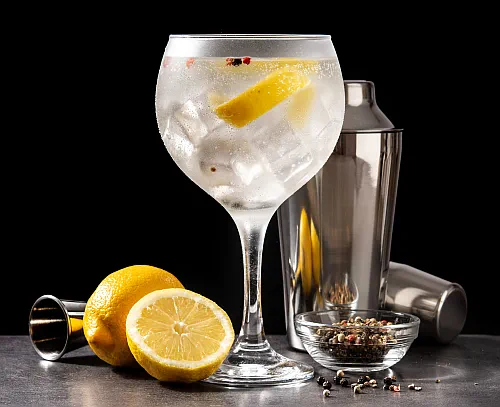Gin: A Spirit of Versatility and Flavor
Gin, a spirit celebrated for its versatility and rich botanical flavors, is defined by its unmistakable juniper essence. However, the beauty of gin lies in the boundless creativity it allows, with its flavor profile extending far beyond the juniper berry. Typically crafted from a neutral grain distillate akin to vodka, gin is elevated by infusing various botanicals, including spices, citrus peels, and aromatic herbs. The style and character of gin can vary immensely, influenced by the specific blend of botanicals used and the sweetness introduced during its creation.
Exploring the Types of Gin
- London Dry: The quintessential gin, London Dry is renowned for its clean, crisp profile. Unsweetened and with a pronounced juniper flavor, it’s the epitome of classic gin, offering unparalleled versatility in mixology.
- Plymouth: Unique to Plymouth, England, this style is less juniper-centric than its London counterpart. It boasts a fuller body and an earthier botanical blend, making it a distinct and flavorful choice.
- Old Tom: A sweeter, slightly maltier variant of gin, Old Tom bridges the gap between the dryness of London Dry and the rich sweetness of other styles, offering a subtly different gin experience.
- Sloe Gin: This is not gin in the traditional sense but a bittersweet, nutty red liqueur. Made by infusing gin or a neutral grain spirit with sloe berries and sugar, it’s the star ingredient in the classic sloe gin fizz.
- Genever: The forebear of modern gin, genever is a malted grain-based spirit rich in botanicals. With a whiskey-like robustness, it’s a unique spirit confined to Holland and Belgium.
- Modern Gin: These contemporary gins dial back the juniper for a more balanced interplay of citrus, herbs, and spices. They sit comfortably between flavored vodka and traditional London Dry, making them a hit in craft cocktails.
- Aquavit: While not a gin, Aquavit shares a kinship with it. Distilled from grain or potatoes, its primary flavor comes from caraway, complemented by a blend of herbs and spices rather than juniper.
Mastering Gin in Mixology
Gin’s assertive flavor profile sets it apart from more neutral spirits like vodka, demanding a more thoughtful approach to cocktail crafting. When harmonized successfully, gin can elevate a drink to new heights of complexity and flavor.
- Embrace Aromatic Mixers: The botanicals in gin find natural companions in aromatized wines like vermouth and Lillet, as well as in bitter spirits like Campari and concentrated bitters such as Angostura, Peychaud’s, or orange bitters.
- Leverage Fresh Citrus Juices: Since many gins are infused with citrus peels, they naturally complement cocktails with sweetened citrus juices, enhancing the overall flavor profile.
- Prioritize Chilling: To truly appreciate the nuances of different gin brands, tasting them at room temperature is ideal. However, when it comes to mixed gin drinks, coldness is key. Use ample ice, keep your mixers like club soda or tonic refrigerated, and if you’re shaking, do so until the shaker becomes almost too cold to handle.
The Most Known Cocktails, Including Gin
Gin & Tonic, Negroni, Tingling Negroni, Martini, Tom Collins, French 75, Citrus 75, Bronx, Aviation, Gin Fizz, Ramos Gin Fizz, Corpse Reviver No. 2, Bee’s Knees, Lavender Gin Cocktail, Southside, Singapore Sling, Rosemary Salty Dog, When the British Came to Spain, Basil Gimlet, Ginger Rogers, Death at the Savoy, Two Palms, Green Lantern, CDT Sunset, Pimm’s Cup, Norseman.
Did You Know About Gin?
- Origin in Medicine: Gin’s origins can be traced back to the Middle Ages when it was initially used as a medicinal liquor. Monks and alchemists in Europe distilled spirits with juniper berries for their supposed healing properties.
- Dutch Roots: Modern gin evolved from a Dutch liquor called jenever, a malted spirit that was originally a medicinal tonic. British soldiers fighting in the Low Countries during the Thirty Years War appreciated its warming properties during cold weather, calling it “Dutch Courage.”
- The Gin Craze: In the early 18th century, England experienced a period known as the “Gin Craze.” Cheap and widely available, gin consumption in London skyrocketed, leading to social problems and the eventual implementation of stricter distillation laws.
- The Invention of the Cocktail Shaker: The cocktail shaker is believed to have been invented due to gin. In 18th-century England, gin was often served in a container with a built-in strainer, a precursor to the modern cocktail shaker.
- Gin and the British Navy: The British Royal Navy played a significant role in the popularity of gin. Navy officers received a gin ration, and British sailors mixed gin with lime to prevent scurvy, leading to the term “limey” for British sailors.
- The First Flavored Gin: Old Tom Gin, a slightly sweeter version of the standard gin, is considered the first flavored gin. It was popular in 18th-century England and played a significant role in developing the Tom Collins cocktail.
- Gin and Tonic’s Malarial Roots: The quintessential gin and tonic was born out of necessity. British colonialists in India drank tonic water with quinine to prevent malaria and mixed it with gin to make it more palatable.
- World’s Strongest Gin: As of my last update, the world’s strongest gin was created by a small distillery in Scotland, titled “Twin River Uncut Gin,” with an ABV (alcohol by volume) of 77%.
- Gin’s Botanical Diversity: While juniper is the predominant flavor in gin, there are typically between six and ten other botanicals used in gin production. Some gins use over 30 different botanicals, offering a vast spectrum of flavor profiles.
- Gin in Literature: Gin has been a favorite in literature, notably in the works of F. Scott Fitzgerald and Ernest Hemingway. Fitzgerald often wrote about gin because he believed its scent was harder to detect on his breath.
In conclusion, gin is not just a spirit; it’s a canvas for creativity. Its diverse styles and the intricate balance of botanicals offer endless possibilities for crafting sophisticated and flavorful cocktails. Whether you’re a seasoned mixologist or a curious enthusiast, the world of gin invites you to explore and experiment, promising a journey filled with delightful discoveries.

